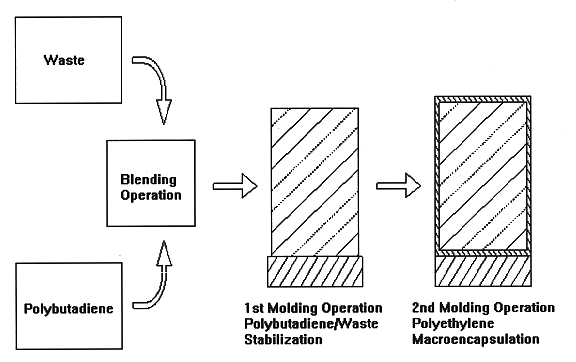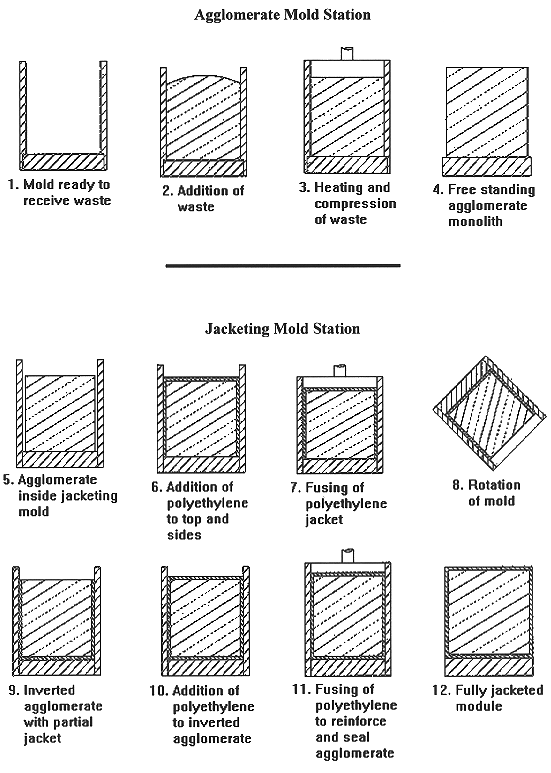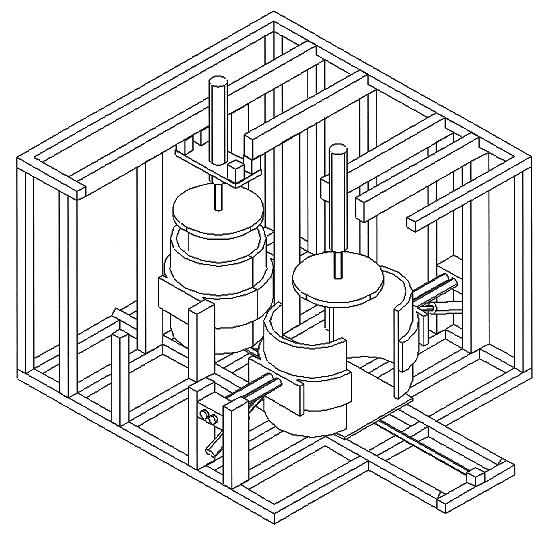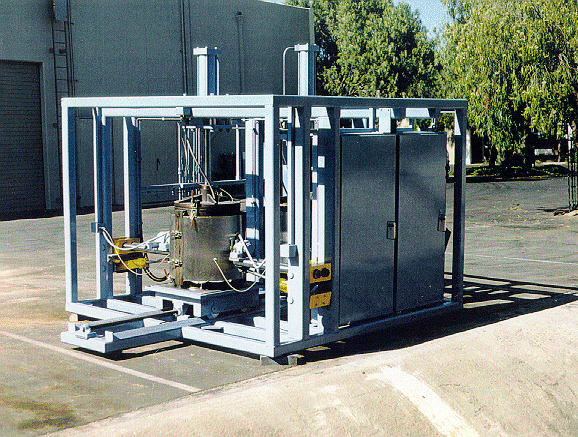
Fig. 1. Process flow.
M.J. Mechsner
Schober's Machine & Engineering
ABSTRACT
Schober's Machine and Engineering has designed and constructed a mobile treatment apparatus capable of stabilizing mixed low-level waste. This high performance waste stabilization process secures low-level, mixed, and organic wastes in a composite polymer module that is readily fabricated with commercially available materials and simple processing equipment.
The equipment is capable of producing full sized (1,000 pound) modules that stabilize the mixed waste in a polybutadiene matrix which is mechanically stabilized by a seamless thermoplastic wall. This process has a working temperature of less than 350°F.
Neither the process or the composite waste form requires auxiliary containers which are subject to damage, corrosion, and costly storage. The composite module shape approximates that of a 55 gallon drum, thus making the modules manageable by conventional drum handling equipment.
The full sized modules are produced by a patented staged mold. Schober's has designed and constructed a transportable stabilization unit. The modules are produced systematically in agglomeration and encapsulation molds whereby the mold base indexes the module between molds by a remotely controlled indexing motor. Schober's is currently developing designs for effective machinery to support fixed operations. These designs include multiple agglomeration molds that are indirectly heated and encapsulation molds that are directly heated.
This equipment was designed and constructed to demonstrate full scale capabilities of a polymer stabilization process developed by Environmental Protection Polymers. The process has shown excellent performance in preventing leaching and superior mechanical stability under stresses that would be encountered in disposal activities
The benefits of the process include conservation of space in landfills as the polymer composite allows for a very high waste loading. Wastes that cannot be managed by aqueous cement such as salts and petroleum products can be treated. Lastly, the final cost of disposal is comparable to cementitious fixation.
INTRODUCTION
This paper offers an additional stabilization process with demonstrated equipment design which will complement the current processes for selected mixed low-level wastes (MLLW). We will offer a commercially viable stabilization process, a completed prototype machine apparatus, and conceptual designs that will enable cost-effective stabilization of wastes within resin-encapsulated modules.
The process described was originally developed by Environmental Protection Polymers (EPP)under EPA sponsorship. (1) The end waste form is a module that is designed to advance the Department of Energy's (DOE) goals of high volume reduction and minimal secondary waste stream generation. It consists of a highly-loaded waste-polymer monolith (preferred polymer: 1, 2, Polybutadiene) that is fully encapsulated by a thick barrier of polyethylene. The Polybutadiene is used commercially as a high performance component of adhesives and sealants. Polyethylene is used throughout the waste management industry as a high performance barrier material.
The modules are designed to withstand storage, transport, and disposal stresses so that no further processing will be required. They have shown compressive strengths greater than 1,500 psi on a laboratory scale.
The waste forms are highly durable and publicly acceptable thanks to the polyethylene jacket component of the module. The Environmental Protecting Agency (EPA) has identified polymer macro-encapsulation in 40 CFR 268.40 as the Best Demonstrated Available Technology (BDAT) for certain solids. Macro-encapsulation (MACRO), 40 CFR 268.42, is defined as applying surface coating materials such as polymer organic (e.g. resins and plastics) or a jacket of inert inorganic materials to substantially reduce surface exposure to potential leaching media. Macro has been designated in 40 CFR 268.45 as an Immobilization Technology under Alternative Treatment Standards for Hazardous Debris (defined as waste with dimensions greater than or equal to 60 mm). With the EPP process we take the stabilization/MACRO process a step further to deliver a superior product for certain requirements, and another option for the industry.
There is no need for secondary containers. The Polybutadiene inner core stabilizes the MLLW. The MACRO jacket that is applied to the module needs no steel drum, overpack, or wooden crate to physically contain the module.
The polybutadiene in the agglomeration module is not flammable after it is cured . The polyethelene can be formulated with fire retardents for the jacket if necessary.
There is nil increase in processing the MLLW into the waste form module. Potential loadings of more than 90% w/w waste have been achieved, thereby minimizing final waste volume.
The EPP process delivers a module that is simple, reproducible, has high uniformity, and is very forgiving during the waste blending portion of the process. This process can be compared to other polymer systems in use such as microencapsulation, macroencapsulation, and two component resin systems. (2,3)
Polyethylene micro-encapsulation entails hot melt blending which can be corrosive to equipment when treating certain wastes. It also requires careful control of the waste/polyethylene blending as it is a throughput process; once the blending has begun inside the extruder it is difficult to change the loadings of waste to polymer, and the product mix is not observable until it exits the extruder making any changes to the mix occur after the fact.
Polyethylene macro-encapsulation, as presently practiced, is extruded into open-air molds, thereby allowing bubbles or near surface voids to form in the waste form requiring additional repair work.
Two component resin systems (i.e. epoxies) are sensitive to poisoning by impurities and are very time sensitive. If the curing agent is not added at the right time or in the right concentration, the end product will be of poor quality.
In contrast, the EPP process uses 1,2 Polybutadiene (a thermosetting polymer), that has the consistency of molasses at room temperature. It will not harden or "kick-over" until it reaches a temperature of over 350°F. However, elevating the temperature by warming (up to 150/200°F) and the Polybutadiene becomes less viscous thereby enabling it to be sprayed onto the MLLW. Alternately, a simple mixer could be used to blend the waste/polymer mix. Also, since this blending operation is not a through-put process and does not have a time constraint, it can be halted for a period of time and restarted a few hours or days later, always having the option of adding more waste or polymer.
Because of the simplicity of the process the equipment is also of simple design. Though designed for the application, the actual process parameters are easy to understand and control thus delivering a consistently high quality product.
The present prototype equipment produces a waste form that is cylindrical in geometry; 2 ft. in diameter and 2 ft. in height. This module weighs approximately 800 lbs. Other shapes and sizes can be produced depending upon the requirements of the disposal operator or type of waste. Process Description
The first step in the process is the blending of the waste with Polybutadiene. As previously discussed, the blended MLLW and Polybutadiene does not have a set shelf life. Additional blending and increasing of either the MLLW or Polybutadiene can be done at a later time.

Fig. 1. Process flow.
Blended waste, the agglomerate, is now ready to be placed in the first mold. This mold consists of an outer, heated jacket, a removable lower platen, and a hydraulically actuated upper platen.
The agglomerate mold jacket is designed to fit over the lower platen in such a way as to produce a monolithe that is smaller in diameter than the final waste form. The difference between the agglomerate diameter and the final waste form diameter will determine the polyethelene jacket wall thickness.
In the prototype machine the blended waste was added to the mold using buckets. A chute or auger conveyor could also be used.
Once the blended waste is in the agglomerate mold the upper platen is brought down hydraulically and light compression (1-2 psi) is maintained on the blended waste during processing. Electric resistance heaters mounted on the outer wall of the mold heat the agglomerate to approximately 350°F. At this temperature the thermo-setting Polybutadiene starts to cross link and harden. It is an exothermic process so even though the outer layer of hardened agglomerate insulates the interior from heating, the chemical reaction continues the heating to the core. Correct heating of the core is monitored with the use of an expendable thermocouple. There are cooling channels in the wall of the mold to allow for rapid cooling of the agglomerate monolith.
The agglomerate mold jacket is now removed. The lower platen is stationed on top of a movable truck that is actuated with an electric servo motor. The truck, lower platen, and agglomerate monolith are now moved into position at the jacketing mold station.
The jacketing mold station is composed of 2 half clamshell sides as well as a top and bottom platen . The clamshell sides can be attached with clamps to both the upper and lower platens. When the clamshell sides are closed, this jacket leaves open the annular space that was formed in the first molding operation. Polyethylene pellets are poured around the side and on top of the waste agglomerate. The upper platen is then brought down, locked in place, and the clamshell sides as well as the top platen are heated using electric resistance heaters. This fuses the polyethylene onto the agglomerate. An unexpected benefit was found to occur. Depending upon the waste loading of the Polybutadiene, stress cracks and fractures would appear in the waste agglomerate. During the jacketing process we found the polyethylene would actually migrate into these cracks, thus making the monolith mechanically stronger.

Fig. 2. Agglomeration and jacketing
molding operations.
There are cooling channels embedded in the side of this mold as well. After cooling we now have an agglomerate waste form that has a seamless, polyethylene jacket surrounding the outside diameter as well as on top.
To seal the bottom the mold must be inverted. Both the top and bottom platens are removable and interchangeable. They are each attached to the clamshell halves with tooling clamps. Each of the clamshell halves are on a pivoting arm structure. These arms are able to raise the jacketing mold with both platens attached. Once raised, the positioning truck is moved from underneath the enclosed mold. Hydraulic rotary actuators now invert the mold. What was previously the bottom has now been rotated to the top. The arms now raise the overturned mold so that the truck can be positioned underneath the mold assembly.
The upper platen is now raised, exposing the unsealed end of the agglomerate. Additional polyethylene pellets are now added to cover this end. The upper platen is now brought down and attached to the clamshell sides. The top one third of the sides are heated as well as the upperplaten, fusing the added polyethylene to the jacketed monolith. After cooling, the upper plated is raised, the clamshell opens, and a macro encapsulated monolith is trucked to an off loading station where commercial drum handling equipment can remove the waste form.
Compared to present waste disposal technology using polyethylene the EPP process has two unique features; the up-ending rotation, and a closed, pressurized mold capable of using high molecular weight plastics.
The up-ending rotation is provided as a means whereby the agglomerate is always macro encased with whatever wall thickness of polyethylene that the molds were designed to deliver. A concern before the construction of the prototype was that if the polyethylene were either injected around the agglomerate or polyethylene were extruded into an open mold it would be possible for the agglomerate to either float or sink in the molten plastic, depending upon the density of the waste. This movement of the agglomerate within the macro encapsulate would allow the wall to be too thin in certain areas. If supports were used to hold the agglomerate, then there would be a potential conduit where leaching could take place. If the supports were cut back and repaired with additional polyethylene it would add an additional process with quality assurance concerns.

Fig. 3. The prototype unit with both
the agglomeration and jacketing molds illustrated.
The EPP process is able to use higher density and molecular weight polyethylene as compared to the present macro encapsulation processes that are in use. For the present processes in use, the lower density and molecular weight polyethylene is necessary so that the extruded polyethylene will flow. The EPP process is able to use higher grade, engineering polyethylene and it encapsulates the agglomerate by powder fusion enabling the plastic to infuse into the waste agglomerate while demonstrating no residual stresses.
When using extruded polyethylene the hot resin comes into contact with the room temperature waste form and immediately starts to harden. As additional polyethylene is added it causes laminations between the cooling resin already in place and the newly added plastic. These laminations cause internal stresses in the plastic that could conceivably cause problems with the waste form when exposed to long term storage. Also, as new layers are added it is possible to trap air between the layers of resin that are difficult to remove.
In the EPP process we see no residual stresses and a superior molecular bond both within the polyethylene as well as how it fuses onto the Polybutadiene agglomerate.
Once the polyethylene pellets are within the closed mold they are heated. As they melt the longer molecules of the high molecular weight plastic starts to knit together. Constant pressure from the platen allows the polyethylene to migrate into any fissures or porosity that might be encountered on the surface of the agglomerate. Since there are no laminations in the plastic we have a stress free monolith.
Table I Comparison of polymer systems
CONCEPTUAL PRODUCTION DESIGN
The present prototype machine (Fig. 4) was designed to be transportable to a remote site by commercial means. It has the capability of being placed directly into a DOE or nuclear facility and would be able to perform commercial scale production on a limited basis. The unit only requires 440 volt, 3 phase power and cooling water to be operational.

Fig. 4. Mobile treatment apparatus.
In the case of our prototype machine limited commercial scale production would be defined as stabilizing and jacketing 1400 to 2100 pounds of waste a day (2 to 3 modules). The production constraint of this unit is the first stage agglomerate fabrication; this process can take from 2 to 5hours depending upon their heat transfer capacity of the waste being treated.
The jacketing stage is relatively quick. An agglomerate monolith can be macro-jacketed in 1 to 2 hours depending upon the temperature of the agglomerate. On future designs of a full production unit the two molding operations will either be separate processes or a single production apparatus with a continuous flow through design.
Keeping the agglomerate fabrication and jacketing station separate has benefits, Man power can be utilized in the blending of the waste and Polybutadiene while another mixture is being processed in the agglomeration mold. After processing these agglomeration monoliths can be staged for a period of hours or days, and later the jacket can be fused onto the agglomerate.
In the through put scenario the mold bases can either be put onto a straight line or a circular production process line. In either of these two conceptual designs a free standing oven would surround a portion of the track. The agglomerate molds could be staged in the oven over night where the agglomerate would set up. During the day the operators would jacket the agglomerate and prepare the next day's production.A key goal of polymer waste stabilization processes is simple and effective processing machinery. This paper describes prototype machinery and full-scale design concepts for an advanced polymer waste stabilization processes. The machinery processes radioactive waste and polymers into advanced waste modules. This paper describes the stabilization process, prototype machinery and design concepts for advanced machinery for full-scale processing.
REFERENCES